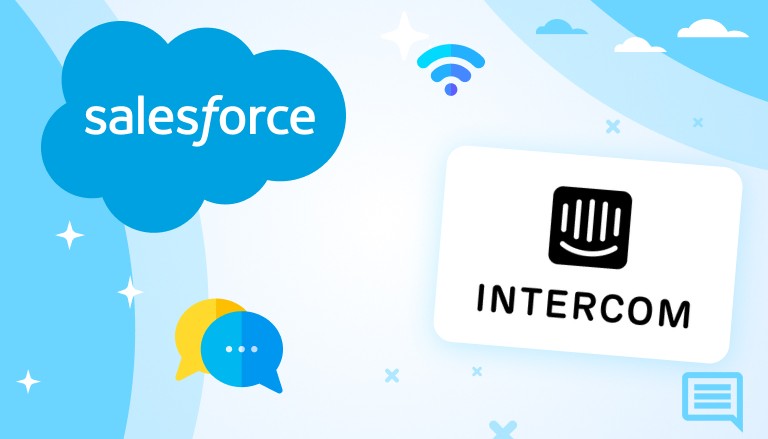
Introduction: Why Integrate Intercom With Salesforce?
Intercom and Salesforce integration is an effective way to manage customer relationships more efficiently. This guide will explain how to integrate the two systems, provide recommendations for tools that make the process easier, estimate costs, and answer common questions. Whether you’re new to integration or looking to enhance your setup, this guide will help you get started.
What is Intercom?
Intercom is a platform that helps businesses communicate with their customers through live chat, in-app messaging, email, and more. It is used by teams to connect with customers, provide support, and improve communication.
Salesforce Intercom integration allows you to connect customer conversations with your CRM. While Salesforce manages your customer data, it doesn’t always track every interaction. By linking Intercom with Salesforce, you can make sure that customer chats, emails, and messages are saved directly in Salesforce, giving you a full view of customer interactions.
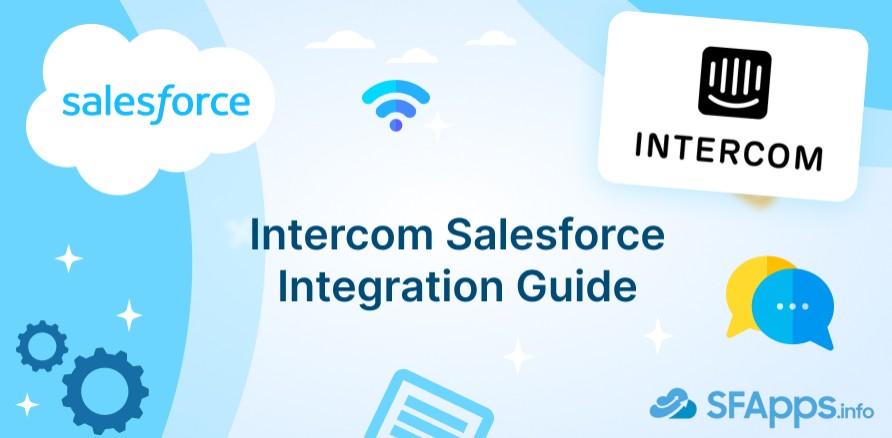
What Are the Benefits?
- Automated Workflows: syncing customer messages automatically saves time. Teams don’t need to enter data manually.
- Better Lead Tracking: lead information from chats can be sent to Salesforce, helping your sales team respond to new leads quickly.
- Complete Customer Data: conversations from Intercom are connected to Salesforce records, giving you a full view of each customer’s activity.
- Team Collaboration: sales and support teams can share customer information more easily when both platforms are connected.
This guide will show you how to set up the integration, along with apps to use, cost estimates, common questions, and more. For more ways to enhance customer relationship management, check out our guide on RingCentral Salesforce Integration for communication solutions within Salesforce.
Setting Up Intercom and Salesforce Integration
When it comes to integrating Intercom with Salesforce, you have several options to choose from. You can use the App Store available in your Intercom account for a straightforward integration. This app connects customer conversations and data directly to Salesforce, allowing for easy tracking of customer interactions. Additionally, you might consider using third-party tools that facilitate connections between Intercom and Salesforce without requiring coding skills. Each method has its benefits, and we’ll help you decide which one works best for your business. Please note: this app is not available for installation via the Salesforce AppExchange. Check our guide VoIP Integration with Salesforce on how to connect voice systems with your CRM and to see how it can improve customer communication.
Insight:
Connecting Intercom and Salesforce gives your support team better information about customers. When data from Salesforce is synced to Intercom, agents can see important details about customers right away, making it easier to help them quickly. This leads to happier customers and more effective support.
Steps to Integrate Intercom with Salesforce Using the App
Intercom integration with Salesforce is straightforward when using the Intercom app. You can start with a free trial to explore the features before committing. Follow these easy steps to set up the integration:
- Log in to Your Intercom Account: start by logging into your Intercom account or create a new account where you manage customer communications.
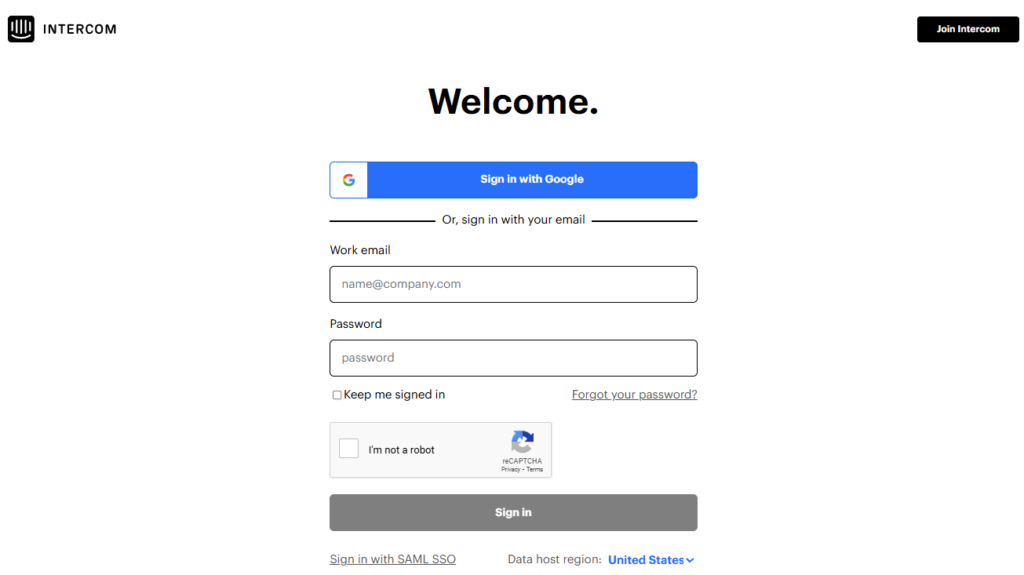
- Access the App Store: navigate to the Intercom App Store in Settings, where you can find various apps to enhance your Intercom experience.
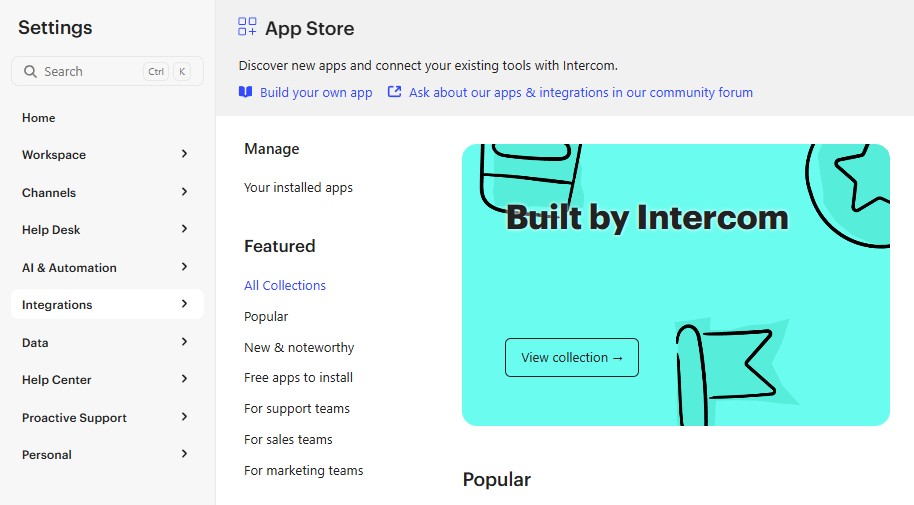
- Find the Salesforce App: in the App Store, search for the Salesforce integration app. Once you locate it, click on it for more details.
- Install the App: click on the “Install” button to add the Salesforce app to your Intercom account. This step allows the app to connect to your Salesforce data.
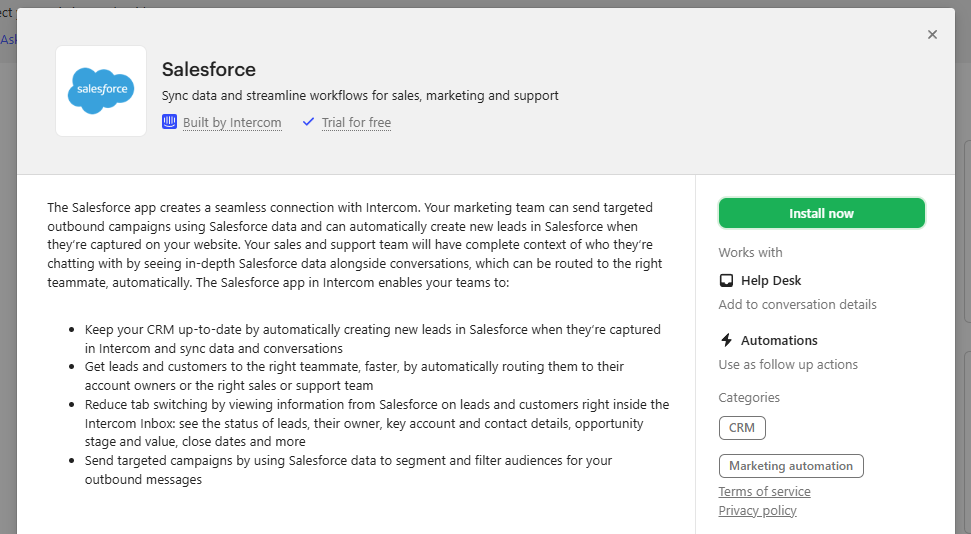
- Connect Your Salesforce Account: follow the prompts to link your Salesforce account with Intercom. You may need to enter your Salesforce login credentials to authorize the connection.
- Configure Settings: once connected, you can customize the integration settings. Decide what data you want to sync between Intercom and Salesforce, such as leads, contacts, and conversation history.
- Save Your Changes: after configuring the settings to your liking, make sure to save all changes. Your integration is now complete!
Benefits of Integrating Salesforce from the Intercom App Store:
- No coding required: it’s perfect for teams without development resources.
- Quick setup: the integration can be completed in just a few clicks.
- User-friendly: app offers an intuitive interface and support from the provider.
This option is ideal for businesses that want a straightforward solution to get started quickly without having to dive deep into customizations.
Which Option Should You Choose?
To choose the best integration method for your business, consider the following:
For a quick and easy solution, opt for apps from the Intercom app store. These are perfect for small to mid-sized businesses that want a straightforward setup with minimal customization.
If you have specific needs and require advanced features, look for apps that offer more control over the integration process. This is a better fit for larger companies with technical resources.
By selecting the right app, your team can access crucial customer data easily. We’re here to help you create an efficient system that connects your communication and CRM tools.
Looking to connect Salesforce Service Cloud with a phone system? Explore our Salesforce Service Cloud Telephony Integration post to learn how to set it up.
Best Apps to Sync Intercom with Salesforce
The native Intercom app for Salesforce is a great starting point for many businesses, but sometimes you need additional tools to enhance the integration. Whether you’re looking for more flexibility, deeper data syncs, or automation options, here are some excellent apps to consider for building Intercom to Salesforce integration:
1. LeadsBridge
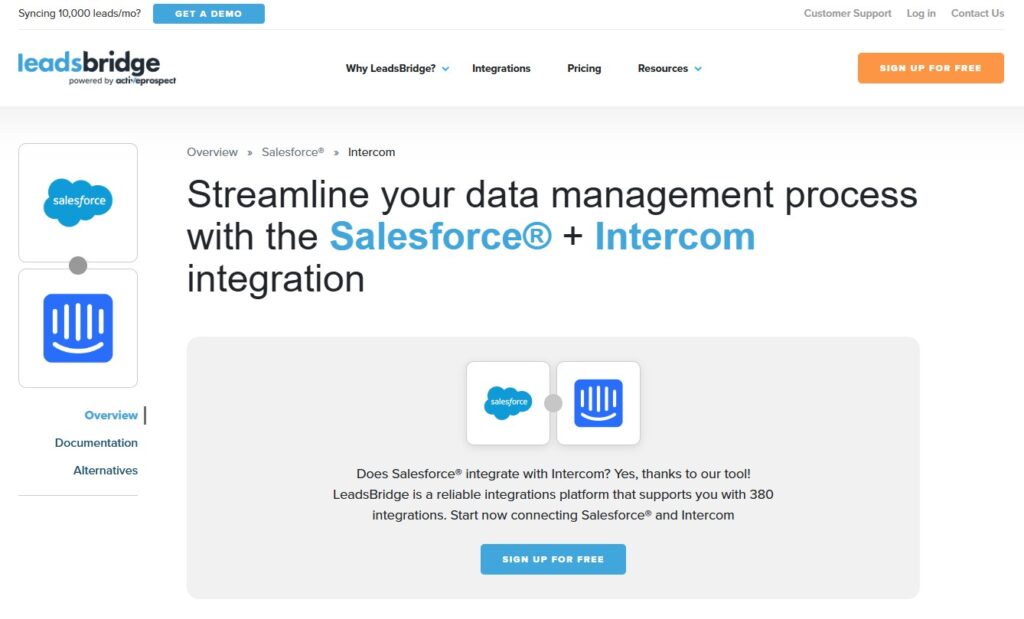
LeadsBridge is a simple powerful platform that automates data transfer between Intercom and Salesforce. It allows businesses to sync customer conversations, leads, and interactions in real-time, ensuring no valuable data is missed. With LeadsBridge, there’s no need for coding, making it accessible to both technical and non-technical teams.
The platform supports real-time data sync, so when a lead or customer interacts via Intercom, their details are instantly available in Salesforce. This makes LeadsBridge a great choice for businesses that need fast, accurate information to improve lead management and customer service.
Pricing: starts at free, depending on the number of leads and bridges you need, and goes up to $999/month for a fully customized solution.
2. Jitterbit
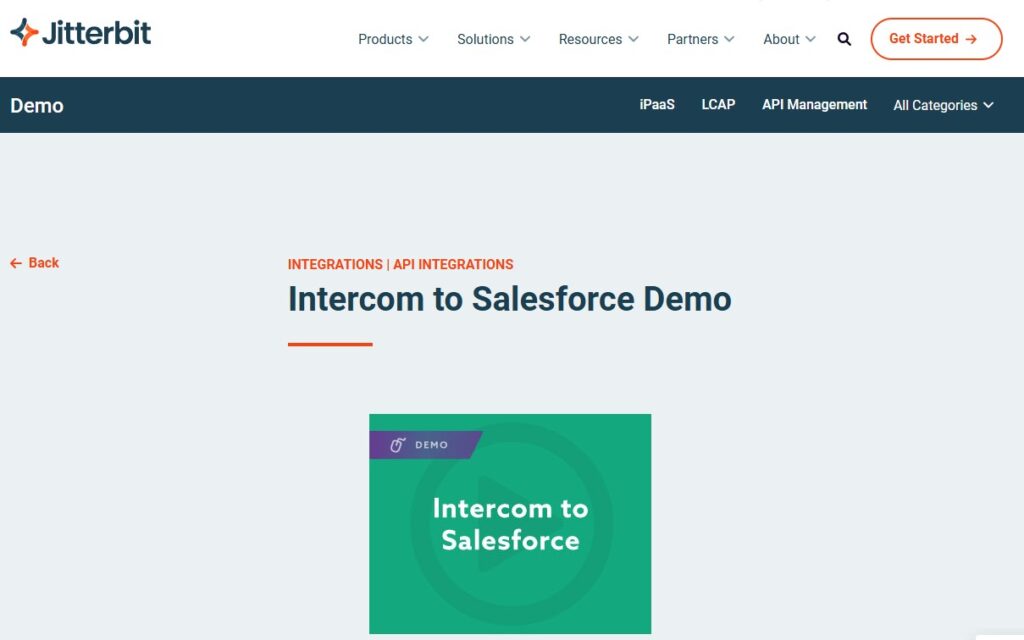
Jitterbit rated 4.88 on the AppExchange, it helps businesses connect Salesforce with any app – cloud or SaaS. Starting at $1,750 USD per month per company, with discounts for nonprofits, Jitterbit’s low-code, clicks-based integration tool delivers quick results. This cloud-based platform has an easy-to-use interface, allowing users to create powerful integrations and see ROI in just days. Jitterbit has pre-defined integration templates and you can also build your own reusable application connectors by utilizing Connector Builder.
Pricing: Starting at $1,750 USD per month per company, with discounts for nonprofits.
3. Integrately
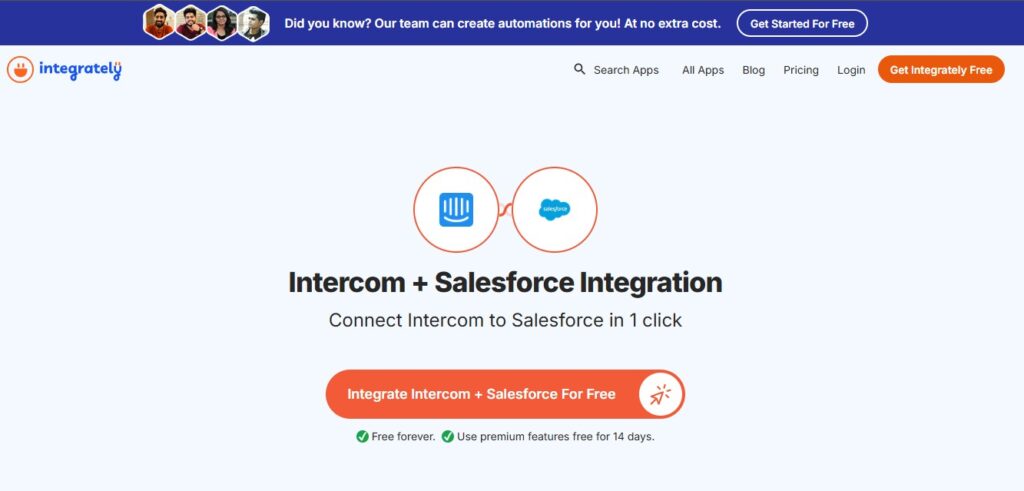
Integrately is a user-friendly automation tool that connects Intercom and Salesforce with ease. It allows users to create workflows without any coding, making it accessible for everyone. With Integrately, you can automate tasks such as syncing leads, updating customer information, and transferring messages between the two platforms.
The platform supports one-click automation, which means you can set up integrations quickly and start seeing results in no time. Integrately also offers a wide range of pre-built templates, making it simple to find the right workflow for your business needs. Pricing starts at no cost and varies based on the number of tasks you need.
Pricing: Plans go up to $299 per month for a business package.
4. Talend
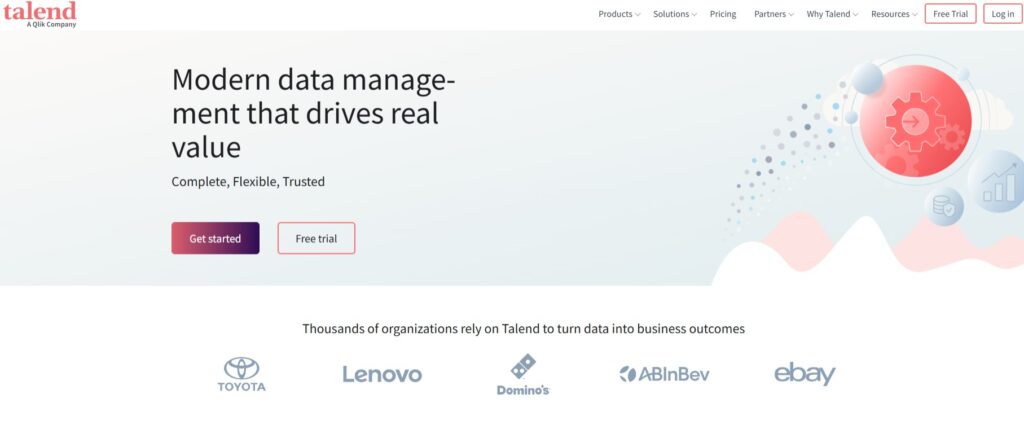
Talend is a powerful data integration platform designed for handling large data sets and complex integrations. It’s a great choice for businesses needing to sync lots of customer data between Intercom and Salesforce. Talend lets you build custom workflows to sync contacts, conversations, and other important data like custom objects or transactions. This platform gives you full control over data flows, ensuring accuracy across systems.
Pricing: For pricing details, reach out to the Talend team.
5. Boomi
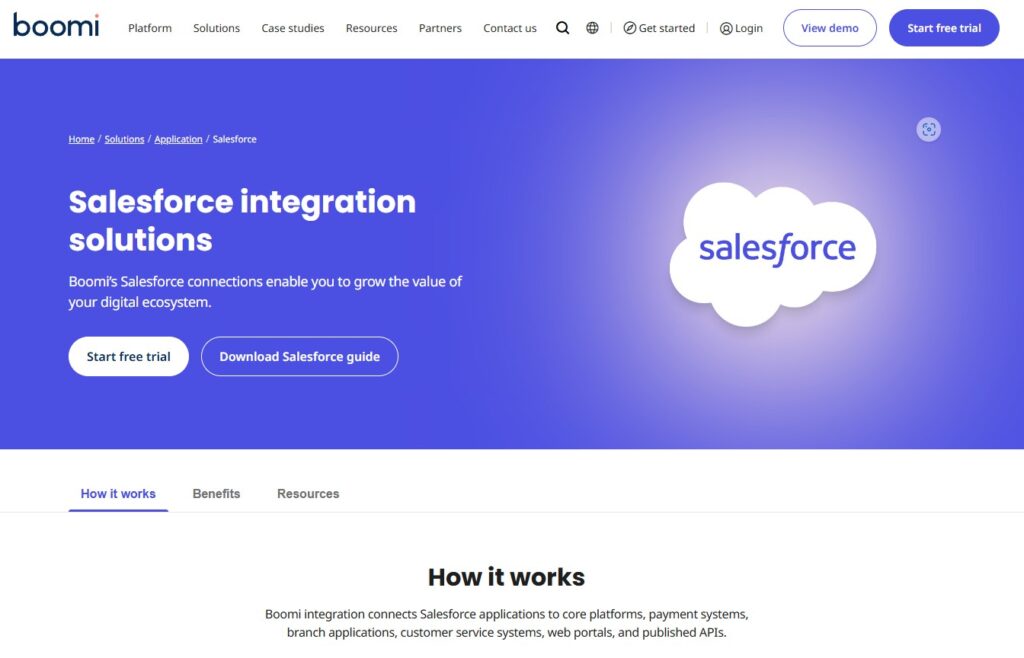
Boomi is another powerful integration platform that connects Intercom and Salesforce. Boomi’s cloud-based platform allows businesses to automate workflows, sync customer conversations, and manage lead data without the need for custom code. It’s ideal for companies that require scalability and flexibility, as it allows for deep customization of workflows. With Boomi, businesses can easily automate the transfer of customer data from Intercom to Salesforce, ensuring that every interaction is recorded, analyzed, and accessible to sales and support teams.
Pricing: For pricing information, please contact the Talend team directly.
Insight:
Instant Updates for Marketing: Integrating these two platforms means that any changes in Salesforce data are updated in real time in Intercom. This helps businesses create better marketing campaigns by using the most current customer information. Targeting the right customers becomes easier, improving overall marketing efforts.
Cost of Intercom and Salesforce Integration
The cost of integrating Intercom with Salesforce depends on both Intercom’s subscription plan and the integration tools you choose. Below is a breakdown based on Intercom’s pricing and two third-party integration tools: LeadsBridge and Jitterbit.
Intercom Pricing Plans
- Essential Plan: $39 per seat/month
Ideal for individuals, startups, and small businesses. This plan offers basic customer support tools, with fewer automation features for integrations. - Advanced Plan: $99 per seat/month
Designed for growing businesses, it includes automation tools and AI features that help streamline your integration between Intercom and Salesforce. - Expert Plan: $139 per seat/month
Best for large teams, the Expert Plan provides collaboration, security, and reporting tools, making it well-suited for handling complex workflows between Intercom and Salesforce.
Example Cost Scenarios
LeadsBridge automates lead management and data integration between tools like Intercom and Salesforce. It’s easy to set up, with pricing starting at $29/month for basic features, making it ideal for businesses needing a simple solution for connecting lead channels with Salesforce.
Integrately is a user-friendly platform that connects apps like Intercom and Salesforce. Pricing starts at $19/month for the Pro Plan, offering 20 automation tasks, with the Business Plan at $49/month for unlimited tasks. Suitable for businesses of all sizes looking for simple automation.
For a team of 5 agents using the Advanced Plan from Intercom and either LeadsBridge or Integrately for integration:
| Integration Tool | Intercom Plan (Advanced) | Salesforce Subscription | Integration Plan | Total Monthly Cost |
| LeadsBridge | $99 per seat x 5 seats = $495 | Your existing Salesforce subscription | LeadsBridge Starter: $29/month | $524/month |
| Integrately | $99 per seat x 5 seats = $495 | Your existing Salesforce subscription | Integrately Pro: $19/month | $514/month |
LeadsBridge offers a cost-effective solution for small to medium-sized businesses, while Integrately provides an easy-to-use automation platform for teams looking to simplify their workflow.
Intercom and Salesforce Integration: FAQs
Why should I integrate Intercom with Salesforce?
Integrating these two systems ensures that customer conversations, support requests, and sales leads are all synced, giving your teams full visibility into each customer’s journey.
Is coding required for this integration?
No, you don’t need to know how to code. Many integration tools like Zapier or the official Intercom app for Salesforce make this a no-code process.
Can I control which data gets synced?
Yes, during the setup, you can choose which fields and data types get synced between Intercom and Salesforce.
How long does the integration take?
If you’re using the official app, it can be completed in 1-3 hours. Custom integrations might take longer, depending on the complexity.
Can I sync real-time conversations?
Yes, with the right integration settings, you can sync live chat conversations from Intercom directly to Salesforce.
Challenges of Integration
Challenge #1: Choosing the Right Integration App
It can be difficult to pick the right app to connect Intercom with Salesforce because there are many options. If you choose the wrong one, it might not meet your needs, causing issues later.
The Solution to Choosing the Right Integration App Issue
Research apps on the Salesforce AppExchange, check reviews and make sure the app fits your needs. Test the app in a sandbox first to avoid problems after implementation.
Challenge #2: Scoping the Integration Project
Many projects fail due to unclear goals or a lack of communication between teams. This can cause delays and confusion.
The Solution to Scoping the Integration Project Issue
Clearly define what the integration should achieve, and make sure everyone involved understands the plan. Outline how data will flow between Intercom and Salesforce to avoid misunderstandings.
Challenge #3: Customization Conflicts
Custom fields and workflows in Salesforce or Intercom can cause errors when trying to sync data.
The Solution to Customization Conflicts Issue
Review any custom fields or workflows in both systems before starting the integration. Make changes if needed to prevent errors and ensure smooth data syncing.
Challenge #4: Authentication Issues
Incorrect API keys or permissions can stop the integration from working properly.
The Solution to Authentication Issues
Make sure API keys and credentials are correct and up to date. Give the integration user the right permissions and check the authentication settings regularly to avoid interruptions.
Challenge #5: Third-Party App Conflicts
If other apps are already connected to Salesforce or Intercom, they might interfere with the new integration, causing errors.
The Solution to Third-Party App Conflicts Issue
Test the new integration to ensure it doesn’t conflict with existing apps. Review any dependencies to avoid issues and monitor the system’s performance to keep everything running smoothly.
Conclusion
Intercom integration Salesforce brings immense value to any company looking to improve customer communication and lead management. The integration is easy to set up using the official app, or you can use automation tools to create more complex workflows. With clear steps and the right tools, you can have this integration up and running in no time, ensuring your team stays on top of customer interactions.

Dorian is a 6X Certified Salesforce Developer and Administrator with a start in the IT world as a CRM Admin in 2020. Since diving into Salesforce in 2021 via Trailhead and Focus on Force, he has achieved a Ranger Rank, earned several Superbadges, and bagged certifications including the Salesforce Certified Administrator, Platform App Builder, Associate and Platform Developer I by 2023. In 2024 he also became Salesforce Certified AI Associate and earned Certified AI Specialist Certification in 2025. Dorian is very keen on continuous learning, always looks for fresh ways to improve his knowledge. He enjoys running, boxing, kickboxing and reading diverse kinds of books in his free time.


 Previous Post
Previous Post Next Post
Next Post